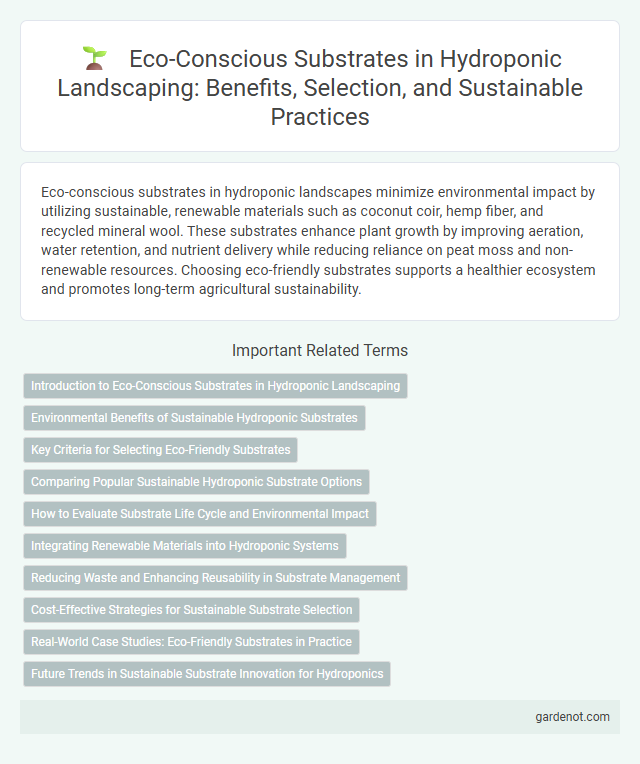Eco-conscious substrates in hydroponic landscapes minimize environmental impact by utilizing sustainable, renewable materials such as coconut coir, hemp fiber, and recycled mineral wool. These substrates enhance plant growth by improving aeration, water retention, and nutrient delivery while reducing reliance on peat moss and non-renewable resources. Choosing eco-friendly substrates supports a healthier ecosystem and promotes long-term agricultural sustainability.
Introduction to Eco-Conscious Substrates in Hydroponic Landscaping
Eco-conscious substrates in hydroponic landscaping prioritize sustainability by using renewable, biodegradable materials such as coconut coir, peat alternatives, and recycled mineral composites. These substrates enhance water retention and aeration while reducing environmental impact compared to traditional soil media. Integrating eco-friendly substrates supports healthier plant growth and aligns with green landscaping practices.
Environmental Benefits of Sustainable Hydroponic Substrates
Sustainable hydroponic substrates such as coconut coir, perlite, and peat alternatives significantly reduce environmental impact by minimizing reliance on non-renewable resources and decreasing waste production. These eco-conscious materials enhance water retention and nutrient efficiency, leading to lower water usage and less runoff pollution in hydroponic systems. Utilizing biodegradable or recyclable substrates supports soil health restoration and promotes a circular economy in sustainable horticulture practices.
Key Criteria for Selecting Eco-Friendly Substrates
Eco-friendly substrates for hydroponic landscapes prioritize sustainability, biodegradability, and minimal environmental impact during production and disposal. Critical criteria include water retention capacity, nutrient-holding ability, pH neutrality, and support for beneficial microbial activity to promote healthy plant growth. Sustainable materials like coconut coir, peat alternatives, and reclaimed organic fibers are common choices that balance ecological benefits with optimal hydroponic performance.
Comparing Popular Sustainable Hydroponic Substrate Options
Coco coir, made from coconut husks, offers excellent water retention and aeration, making it a popular sustainable hydroponic substrate with a low environmental footprint. Rockwool, though widely used for its stability and pH neutrality, raises concerns due to its non-biodegradable nature and manufacturing energy consumption. Perlite and vermiculite serve as lightweight, renewable substrates that improve drainage and root oxygenation while supporting eco-friendly hydroponic systems.
How to Evaluate Substrate Life Cycle and Environmental Impact
Evaluating the life cycle and environmental impact of eco-conscious substrates in hydroponic landscapes involves analyzing raw material sourcing, production processes, and end-of-life disposal methods to ensure sustainability. Key factors include assessing carbon footprint, biodegradability, water retention capacity, and potential for reuse or recycling, which reduce ecological burden. Certifications such as FSC, Cradle to Cradle, and life cycle assessment (LCA) reports provide valuable data for selecting substrates that minimize environmental impact while supporting healthy plant growth.
Integrating Renewable Materials into Hydroponic Systems
Integrating renewable materials like coconut coir, perlite, and rice husk into hydroponic substrates enhances sustainability by reducing reliance on peat and synthetic options. These eco-conscious substrates improve water retention, aeration, and nutrient delivery, promoting healthier plant growth while minimizing environmental impact. Employing biodegradable and recyclable components aligns hydroponic practices with green agriculture principles, optimizing resource efficiency and waste reduction.
Reducing Waste and Enhancing Reusability in Substrate Management
Eco-conscious substrates in hydroponic landscapes minimize environmental impact by using biodegradable or recyclable materials that reduce waste accumulation. Incorporating renewable organic fibers such as coconut coir or rice husk enhances substrate reusability while maintaining optimal water retention and aeration for plant roots. Efficient substrate management practices, including periodic sterilization and nutrient replenishment, extend substrate lifespan and decrease the frequency of replacements.
Cost-Effective Strategies for Sustainable Substrate Selection
Eco-conscious substrates in hydroponic landscapes prioritize renewable materials like coconut coir and perlite, reducing environmental impact while ensuring optimal root aeration and moisture retention. Cost-effective strategies for sustainable substrate selection emphasize locally sourced, biodegradable options that minimize transportation emissions and waste disposal costs. Integrating these substrates not only enhances plant health but also supports long-term economic and ecological sustainability in hydroponic systems.
Real-World Case Studies: Eco-Friendly Substrates in Practice
Real-world case studies demonstrate the effectiveness of eco-friendly substrates such as coconut coir, peat alternatives, and rice hulls in hydroponic landscapes, showcasing improved water retention and nutrient delivery. Research from urban farms in California highlights reduced environmental impact and enhanced plant growth compared to traditional substrates. These innovative materials contribute to sustainable agriculture by minimizing waste and promoting renewable resource use.
Future Trends in Sustainable Substrate Innovation for Hydroponics
Future trends in sustainable substrate innovation for hydroponics emphasize biodegradable and renewable materials such as coconut coir, biochar, and mycelium-based substrates to reduce environmental impact. Advanced substrate formulations enhance water retention, nutrient delivery, and root aeration while minimizing waste and chemical runoff. Integration of smart sensors in substrate systems enables precise monitoring of moisture and nutrient levels, optimizing plant growth and resource efficiency in eco-conscious hydroponic landscapes.
Eco-conscious substrate Infographic

 gardenot.com
gardenot.com